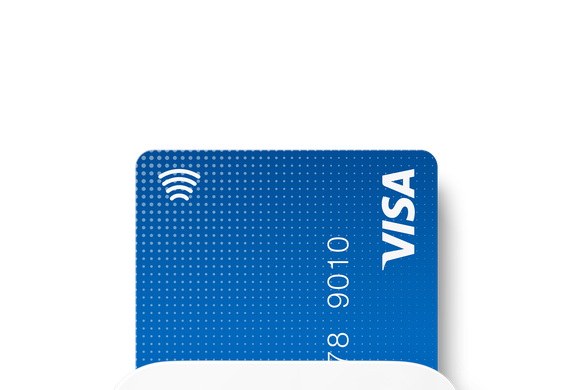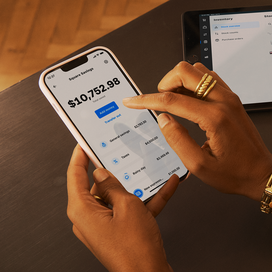Table of contents
EMV, or chip cards, are a more secure type of credit card that uses chips to encrypt bank information, making them more secure than magstripe cards.
In this guide, we’ll explain what EMV is, how credit card chips work, liability shifts for fraud, what it means for your business, and how to protect yourself and accept EMV cards and NFC payments.
What is EMV chip technology?
EMV chip technology — developed and managed by American Express, Discover, JCB, Mastercard, UnionPay, and Visa — is a global standard for credit cards that uses computer chips to authenticate (and secure) chip card transactions.
How does EMV work?
EMV (Europay, Mastercard, and Visa) technology enhances payment security by using EMV chip cards, which contain a microprocessor chip that generates a unique transaction code for every purchase. When the card is inserted into an EMV reader, the chip and reader communicate to authenticate the transaction, making it nearly impossible to replicate the card for fraudulent use.
Additionally, EMV often incorporates tokenization, which replaces sensitive card details with a unique, randomized token during transactions. This ensures that even if the token is intercepted, it cannot access card information, providing protection against data breaches. Together, these features make EMV cards a robust standard for secure payments.
Benefits of EMV for sellers
EMV chip technology offers significant advantages for sellers by improving payment security and streamlining operations. Key benefits include:
- Enhanced security: EMV cards and readers use dynamic authentication, making it extremely difficult for fraudsters to clone cards or steal sensitive data.
- Customer protection: By reducing the risk of fraud, sellers minimize chargebacks and associated costs, protecting their revenue.
- Reduced fraud: EMV’s unique transaction codes and tokenization significantly lower the likelihood of counterfeit card fraud.
- Customer trust: Secure transactions foster confidence in customers, encouraging repeat business and loyalty.
- Global adoption and compliance: Accepting EMV cards ensures compatibility with international payment standards, helping sellers expand their reach while meeting regulatory requirements.
How have EMV cards shifted fraud liability?
Before chip cards, card issuers absorbed the cost of fraudulent transactions. As of October 2015, if a consumer pays with a fraudulent chip card, and your business isn’t set up with an EMV reader, it’s possible that card issuers no longer have to accept liability.
For example, if a customer buys $30 worth of hot sauce from a restaurant with a counterfeit EMV chip card and the restaurant doesn’t have an EMV chip card reader to process the transaction, the restaurant could be on the hook for the $30.
Read more about this liability shift in our Guide to the Liability Shift.
How to protect your business
To protect your business from potential liability for fraudulent transactions, make sure you have a new EMV reader to process information on EMV chip cards.
The Square reader for contactless and chip accepts EMV and NFC payments like Apple Pay and helps protect you from this liability shift.
Future trends of EMV technology
The future of EMV chip technology is poised to evolve alongside the growing demand for cashless and secure digital transactions. As consumers increasingly favor contactless payments, EMV is expected to integrate more seamlessly with mobile wallets and wearable devices, offering faster and more convenient payment options.
Enhanced security measures, such as advanced tokenization and biometric authentication, will further safeguard transactions against emerging threats. Additionally, global adoption of EMV card technology is set to expand, particularly in regions transitioning from magnetic stripe cards, promising a unified and secure payment ecosystem worldwide.
EMV FAQ
Are all credit cards with chips EMV-compliant?
Not necessarily. However, the vast majority of credit cards that have chips are EMV-compliant. If you have questions about your credit card and whether or not it’s EMV-compliant, contact your card issuer.
How do you process an EMV transaction?
You dip the credit card vertically, chip first, into an EMV reader instead of swiping it horizontally on a magstripe reader.
Am I legally required to accept EMV?
No law requires businesses to be EMV-compliant. It’s up to each seller to decide whether or not to upgrade. What has changed is the way that card issuers and the processing networks handle fraudulent charges. But even though the EMV liability shift is not officially a law, it’s a good idea to protect yourself by ordering an EMV reader (like the Square Reader for contactless and chip) so you can accept the most secure forms of payment.
Why do EMV transactions take so long?
If you’ve paid with an EMV chip card, you know firsthand that they take longer to process than magstripe cards. The card has to be inserted into the reader for the entirety of the transaction which can take several seconds because the EMV chip on the credit card is communicating with the EMV reader to make sure you are who you say you are.
The fact that EMV transactions take so long will accelerate the adoption of faster, more convenient payment methods like NFC. NFC (near field communication) payments— also known as contactless payments — are just as secure as EMV payments but take a fraction of the time because they process through your mobile device.
How can I accept EMV at my business?
To accept EMV at your business, you’ll need an EMV-enabled credit card reader. Chip cards are processed differently than magnetic stripe cards. They’re dipped vertically (EMV chip part down) instead of swiped horizontally.
How do I use theSquare EMV reader?
The Square EMV reader is easy to use and compatible with iOS and Android. Here’s how to get up and running:
- Purchase the Square Reader for contactless and chip, which turns most smartphones or tablets into an EMV reader.
- Download the Square Point of Sale app for iOS or Android.
- Ring up your customer in the Square app.
- Insert your customer’s EMV card into the reader. Wait for all of the lights to flash from red to green when the transaction is successful. Square Reader for contactless and chip lets you know when you can remove the card.
- Receive your transfers as soon as the next business day. Square sends payments directly to your bank account in one to two business days.
What’s the difference between EMV and NFC?
EMV and NFC are often mentioned in the same conversations. That’s because they both represent the future of more secure, authenticated payments. However, they’re not interchangeable (a common mistake people make). EMV and NFC are entirely different technologies.
While EMV® (developed and managed by American Express, Discover, JCB, Mastercard, UnionPay, and Visa) is synonymous with chip card technology, NFC (which stands for near field communication) goes hand in hand with contactless, mobile payments. Basically, NFC is the technology that allows smartphones and other devices (like payments readers) to communicate with each other when they’re close together. The devices have to be close though (that’s the “near” part), usually around two inches or less.
What are some other payment trends to watch for?
Soon, NFC contactless payments (aka mobile payments) will begin to pick up steam. This means that more and more people will start paying for things via their smartphones and watches. You can already see contactless payments in action at large retailers across the country — like Walgreens, Whole Foods, and Home Depot, for example.
The progression toward contactless payments is natural. After all, our mobile devices are becoming like another limb. We increasingly look to our smartphones and watches to take care of daily life, relying on them for things like email, social media, and even health monitoring. So, it makes sense that we’ll want to use our mobile devices to pay for things. (For one, it means you no longer have to carry around a wallet stuffed to the brim).
What’s more, contactless payments like Apple Pay are just as secure as EMV payments. They’re dynamically encrypted through tokenization, making them virtually impossible for fraudsters to hack. Apple Pay is also protected by Apple’s fingerprint technology (Touch ID). So even if you lose your phone, all your bank details are protected.
As mentioned before, while EMV transactions are secure, they’re pretty slow. This will likely push people (and businesses) towards faster, more convenient payment technologies like NFC. This will be especially true once people realize they’re just as secure as chip cards.
We’ve seen this trend abroad — countries that have already adopted EMV as the standard have seen a faster acceleration of mobile payment adoption. So it’s worth getting yourself set up to accept both EMV and NFC at your business to stay current with how people will want to pay.
The Square Reader for contactless and chip accepts EMV and NFC payments, so you can securely take any form of payment that comes across your countertop.
Learn more about Square payment processing fees and how they work.
![]()











